Installing a pump for heating: how to properly install pumping equipment
The circulation pump increases the efficiency of the autonomous heating system, allows 100% use of all heating circuits.
Professional installation of the pump for heating guarantees high performance, reduces noise and reduces maintenance and repair costs. The installation of the device does not cause special difficulties, but there are a number of nuances that are important to consider.
We will tell you how to choose a circulation deposit, help you determine the optimal scheme for inserting equipment into the system, indicate installation requirements, and also give step-by-step instructions for installing the device.
The content of the article:
The purpose of the pump for heating
Previously, circulation type pumps were used only in central heating systems, and for private housing construction the natural movement of the coolant caused by the temperature difference was the norm.
Now forced circulation is used everywhere due to the advent of compact and inexpensive models designed to service the heating networks of small houses and cottages.
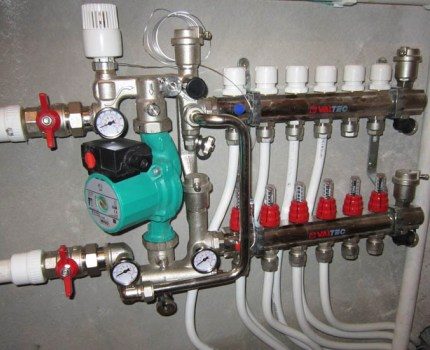
Due to the increase in the velocity of the coolant in the pipeline, thermal energy is supplied faster to the heating radiators, respectively, the rooms are heated faster. The load on the boiler decreased, because the water began to be heated faster.
The need to install bulky and inconvenient large-diameter pipelines disappeared, the contours became easier to mask under the floor or buried in the walls.
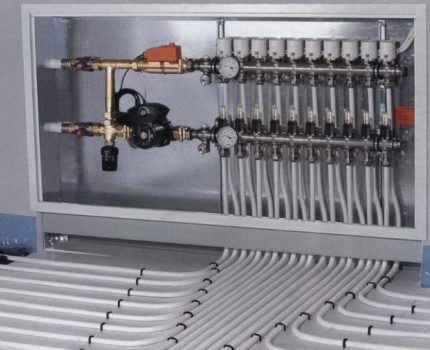
The main disadvantage of pumps for heating systems is their dependence on electricity. If the power is supplied intermittently or there is a risk of a complete power outage for a period, the installation of a backup generator or at least an uninterruptible power supply is necessary.
The remaining disadvantages relate to the designs and functionality of devices of various types. For example, monoblock units and devices with a dry rotor are noisier and require constant maintenance, and a pump with a wet rotor is demanding on the quality of the coolant and has a pressure limit.
Competent equipment selection criteria
All installation efforts will be reduced to zero if the equipment is selected incorrectly. In order not to be mistaken, it is necessary to first analyze all sides of a particular heating system and make the necessary calculations.
The main types of pumps
By design features, all devices are divided into 2 categories: with a wet and dry rotor.
Wet type pumps. This option is suitable for private homes. The unit is compact, almost silent and has a modular structure convenient for maintenance and repair.
But, unfortunately, it does not differ in high performance - the maximum efficiency of modern models reaches 52-54%.
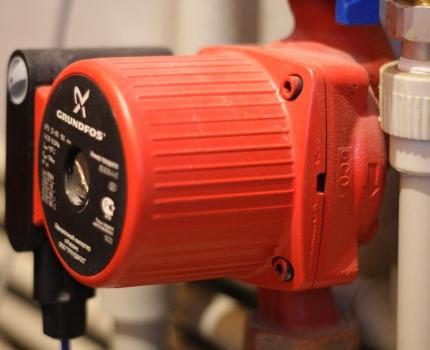
Dry rotor pumps productive, unpretentious to the quality of the coolant, able to work under high pressure and do not require a strictly horizontal arrangement on the pipe. However, they are noisier, and their work is accompanied by vibration. Many models are mounted on a foundation or metal support frame.
For installation of console, monoblock or "In-line" models it is necessary separate room - boiler room. It is advisable to use them when a flow rate of more than 100 m³ / h is needed, that is, to service groups of cottages or apartment buildings.
Technical Overview
When choosing a pump, you should definitely study the technical specifications and compare them with the requirements of the heating system.
Important indicators are:
- pressurewhich covers the loss of hydraulics in the circuit;
- performance - volume of water or supply for a certain time interval;
- coolant operating temperature, max and min - for modern models an average of +2 ºС ... +110 ºС;
- power - taking into account hydraulic losses, mechanical power prevails over useful.
Structural details are also important, for example, the inlet / outlet diameter of the nozzles. For heating systems, the average parameters are 25 mm and 32 mm.

An example of a unit for equipping a heating network of 100 m² housing is a pump Grundfos ups with a 32 mm pipe connection, with a capacity of 62 l / s and a weight of 3.65 kg. The compact and low-noise cast-iron device is not audible behind a thin partition, and its power is enough to transport liquid to the 2nd floor.
Pumps with integrated electronics allow you to quickly translate equipment into a more convenient mode, depending on changes in temperature or pressure in the network. Automatic devices are equipped with digital displays that provide maximum information on the pump: temperature, resistance, pressure, etc.
Additional information on the calculation and selection of the circulation pump for heating is presented in the articles:
- How to calculate a pump for heating: calculation examples and equipment selection rules
- Selection of a circulation pump: device, types and rules for choosing a pump for heating
- Circulation pump for heating: top ten models and tips for customers
Circulation Pump Installation Requirements
There are a number of norms that regulate the installation of a circulation pump in a heating system at the legislative level. Part of the rules is set out in SNiP 2.04.05 “Heating ...”. For example, it says priority circuits with forced circulation in heating networks.
Almost all the requirements are justified by the efficiency of the system as a whole and the circulation device in particular. For example, the shaft of a device with a wet rotor must be installed on the pipe strictly horizontally in level so that no air jams occur inside and pump parts do not wear out prematurely.
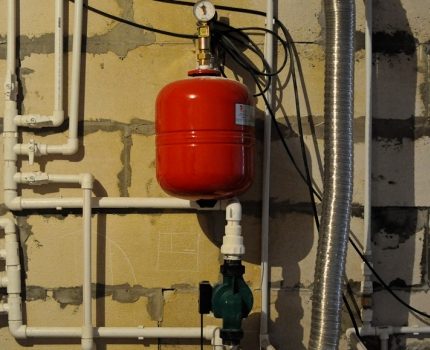
A filter from dirt and abrasive particles is needed in any case, even when installing monolithic models. Filtered coolant will bring much less damage to the pump parts than liquid with sand and suspensions.
The sump is installed with the plug down in the direction of water movement to reduce resistance and facilitate system maintenance.
Manufacturers dictate some rules. For example, it was customary to install old models of certain brands solely on the reverse, since they could not withstand high temperatures.
Now the pumps have become more universal in nature and can be installed in any suitable place, but with observance of power parameters.
Analysis of installation technology
The installation process itself is fast, so to fasten the case, you need to fix two union nuts. It is very convenient for further maintenance and repair work. But before installation it is necessary to choose the installation location correctly, otherwise the pump will either work intermittently or will soon fail.
Schemes of insertion of the pump into the network
Choosing one of the schemes, it is necessary to take into account the type of heating system, boiler model and ease of maintenance.
Option 1. This is the most common solution: the pump is mounted on the "return", through which the cooled coolant is returned to the boiler. Warm water does not act so aggressively on the parts of the device, so it lasts longer.

Option 2. This solution is relevant if it is not possible to install the pump on the “return” for some reason. Then it is fixed at the beginning of the circuit, at the feed, but not near the boiler, but after security groups.
Modern devices easily withstand high temperatures, however, there are still specialists who reject such a scheme.
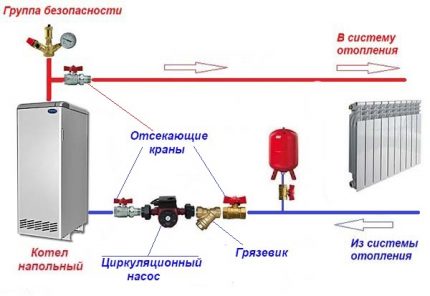
There is such a heating network option as open system with an expansion tank installed at the highest point of the circuit.
If you install a circulation pump, you will be able to operate it in two modes: natural and forced. Natural circulation is useful in the event of a power outage.

The latter scheme applies only to networks with a solid fuel boiler.The feed pump is not installed due to the risk of explosion. Fact that u solid fuel boilers it is impossible to quickly stop the heating process, as a result of which water boils.
Boiling water with steam gets into the pump, it reduces productivity, chilled water in the circuit does not have time to flow back into the boiler in the required quantity - and it is heated even more. Overheating results in an explosion.
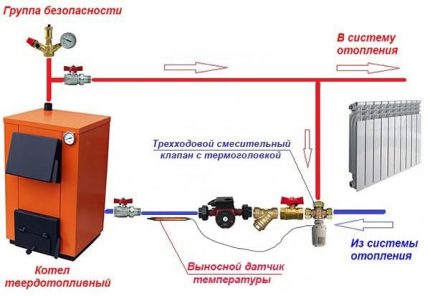
If you start chilled water from the circuit into the heating boiler, condensation will form. To prevent this, the water is first heated in a small circuit to + 55 ° C, and then the thermostatic valve makes a smooth switch to a large circuit.
As a result, cold water is mixed with already preheated and “temperature shock” for the boiler does not occur.
How is piping
The binding of the circulation pump is the equipment necessary for its proper functioning, as well as for the uninterrupted operation of the entire heating system.
First you need to finally decide how many pumps will be. For one simple circuit, one device is enough, but with complex wiring, two or more can be installed.
If the house plans to use the "warm floor" system or install indirect heating boiler, it is better to increase the number of devices to two. If two boilers are installed - solid fuel and electric - a separate pump for each unit will also be required.
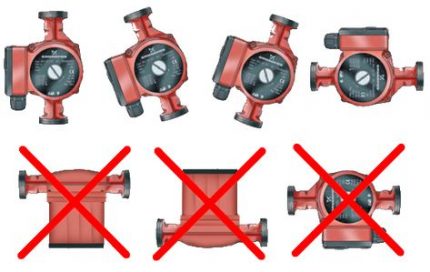
As mentioned above, the required elements are ball valves. They are mounted together with the pump, and in the event of an emergency, they will have to be used.
Necessary and check valve from brass or cast iron so that the coolant moves in one given direction. It is mounted on the pipe immediately after the pump, in the direction of movement of the water.
A dirt filter is required to prevent solid particles from entering the instrument housing. Fine filters are not installed in the heating circuits. If clean water is needed, then it is pre-cleaned before it is poured into the system.
There is a risk of air entering the network, so there is a need to install an air valve. It can turn on in automatic mode, but there are also manual models.
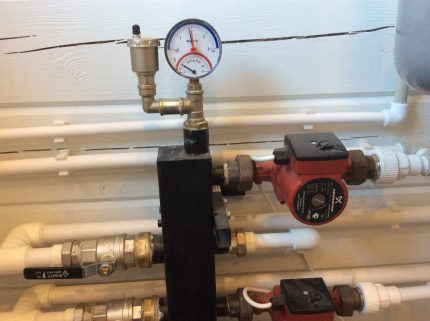
After installation of all devices, the pump is connected to the power supply. The big mistake is to use an ordinary outlet without grounding. This is a safety violation and may be life-threatening at the time of the accident.
There are more reasonable ways of power supply:
- across uninterruptible power supply (UPS);
- through a differential circuit breaker;
- by connecting to the boiler automation.
It’s easiest to use a circuit breaker: you need an 8 A circuit breaker, contacts, wires. But for practical use, a solution with a thermostat is very convenient.
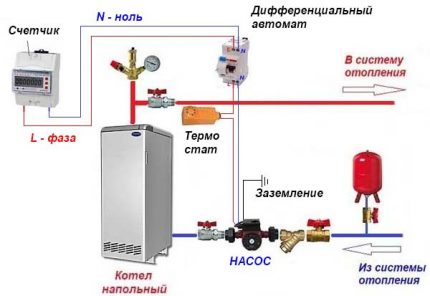
If the installation of the UPS is planned, then you can organize the connection of the uninterruptible power supply to both the pump and the boiler simultaneously.
Quick Installation Guide
A common option is to mount the pump on a bypass. This is due to two good reasons: it becomes possible to quickly dismantle or temporarily disconnect the device from the network, for example, if there are problems with electricity.

There are various modifications of ready-made pumping units for sale: for welding or flange connection, with places for installing taps or valves, with a special section reserved for the pump.
But if the finished unit cannot be purchased or there is not enough space for its installation, you can independently organize the bypass strapping and fix all the details in the places reserved for them.
The following tools and materials are required for work:
- set of open-end wrenches or adjustable wrenches for assembly;
- pliers:
- flax thread or tow;
- Unipak sealant.
American nuts are usually supplied complete with a pump, but cranes, adapters, or shafts will also have to be prepared. Attention should be paid to more reliable material for the manufacture of reinforcement and the diameter of the products.
Procedure:
- Assembly of nodes with cranes. Two will be located at the edges of the pump, the third will become part of a straight pipe. It is important to measure the “return” section in order to precisely weld a fragment with a tap.
- Assembling the pump loop. Tightening the nuts must be moved to the final stage of installation, but for now they should only be screwed.
- Bypass loop fitting. Mark the places of cooking knots in the pipe.
- Weldingwhich should be entrusted to a qualified welder.
- Bottom assembly - on the "return".
- Connection pump to power.
Pump installation as an example GRUNDFOS.
Maintenance of the installed pump is carried out in operating mode. It is necessary to clean the filter more often and check the pressure gauge.
If the values are not correct, the device must be removed and adjusted. It is better to do this in a specialized workshop.
Conclusions and useful video on the topic
Theoretical knowledge is quickly assimilated accompanied by an interesting video that reveals the sequence and features of the installation of devices.
Video review of the WILO pump - configuration and installation:
Practice shows that advanced home improvement lovers cope with the installation of a circulation pump on their own.
However, if difficulties arise, it is better to contact specialists: only qualified craftsmen know how to properly tie and install the pump for heating, observing all the nuances of the selected circuit.
Do you have personal experience installing a circulation pump? Want to share your knowledge or ask questions about the topic? Please leave comments and participate in discussions - the feedback form is located below.

 Installation of a circulation pump: types, purpose and features of its installation
Installation of a circulation pump: types, purpose and features of its installation 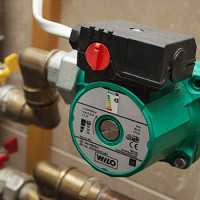 Selection of a circulation pump: device, types and rules for choosing a pump for heating
Selection of a circulation pump: device, types and rules for choosing a pump for heating  Heating from an electric boiler: options for organizing heating based on an electric boiler
Heating from an electric boiler: options for organizing heating based on an electric boiler 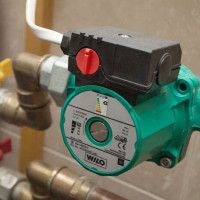 Connection diagrams of the heating pump: installation options and step-by-step instruction
Connection diagrams of the heating pump: installation options and step-by-step instruction 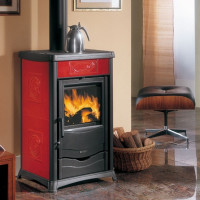 Autonomous gas heating of a private house: device options and an overview of the best solutions
Autonomous gas heating of a private house: device options and an overview of the best solutions  Expansion tank for closed heating: operating principle and device + how to choose and install in the system
Expansion tank for closed heating: operating principle and device + how to choose and install in the system  How much does it cost to connect gas to a private house: the price of organizing gas supply
How much does it cost to connect gas to a private house: the price of organizing gas supply  The best washing machines with dryer: model rating and customer tips
The best washing machines with dryer: model rating and customer tips  What is the color temperature of light and the nuances of choosing the temperature of the lamps to suit your needs
What is the color temperature of light and the nuances of choosing the temperature of the lamps to suit your needs  Replacement of a geyser in an apartment: replacement paperwork + basic norms and requirements
Replacement of a geyser in an apartment: replacement paperwork + basic norms and requirements
It is better to put two pumps at once. Even expensive devices are very flimsy, sometimes they stop pumping from the slightest touch or vibration of the floor. When installing the pump, it is best to make a separate wiring line with your switch on the shield. They consume electricity fairly. If the house is warm and there is no small child, then it is better to do without a pump. The cost of the equipment itself, installation and maintenance greatly shook our family budget. Now we regret that we started this.
Unfortunately, we have established in practice that a pump is not needed in the system - it drives water and it cools faster. And the gas warms it again, and the flow is. Therefore, at the moment, the pump is turned off, and the firebox is going straight through. In view of this, the consumption of firewood on the KORDI wood burning boiler decreased, and very much! I covered the chimney flap for one more revolution, on a manometer of 70 degrees, in the heat rooms, and we are the gainers. Who wants to try it, because the gasmen invented the pump so that they could tear money.
Pumps are needed for underfloor heating, and are still needed where natural circulation is not possible.